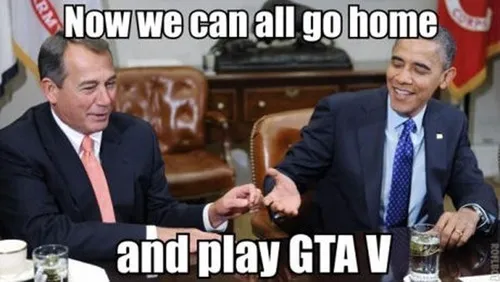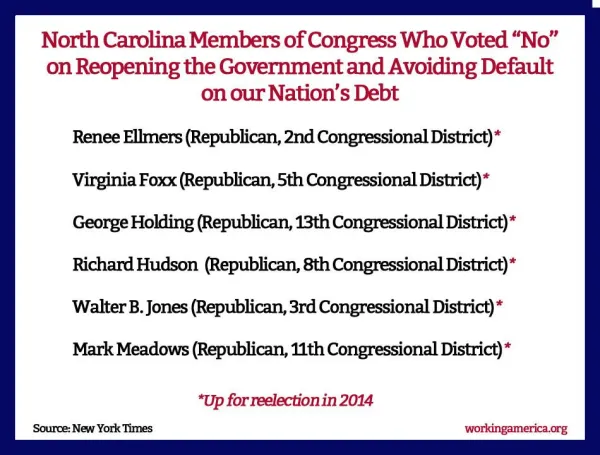
Latest manufactured crisis ends
It's finally over. After 16 long days and with only hours left before the United States defaulted on its debt for the first time, the Republican shutdown of the federal government ended with quick votes in the Senate and House and with the President's signature on a deal that will keep the lights on, the national parks open, and federal workers at work working for the American people - at least for now.
"Finally -- after more than two weeks of government shutdown, with hundreds of thousands of Americans out of work and billions of dollars in avoidable losses -- Republican leaders have stood down," said AFL-CIO President Rich Trumka.
"While it is good news that we have avoided a crisis, we all know that it should never have happened. No party or faction inside a party should hold our economy hostage to extract political gains. We commend President Obama, Majority Leader Reid, and the leadership of the Democratic party for standing firm and resisting extortion." -- Rich Trumka, 10/17/2013
Read Rich Trumka's full statement on the GOP shutdown and debt ceiling deal.
The last-minute deal will fund the federal government through January 15 and allow the U.S. Treasury to continue paying our nation's bills through February 7. The deal requires the House and Senate to immediately begin ironing out differences between each chamber's budget bills and to agree to a long-term spending plan by December 13. Furloughed federal workers will also received back-pay.
"On behalf of the 670,000 federal employees represented by AFGE, I am thrilled that a deal was reached to put our members back to work and restore the services American taxpayers count on," said AFGE National President (and NC State AFL-CIO Vice President) J. David Cox.
"But make no mistake about it, this is not a happy day for federal employees. The Senate deal is simply a brief reprieve from the suffering federal employees and their families have endured for the past sixteen days. We cannot accept another government shutdown in just a few short weeks; federal workers and the public they serve have suffered enough." -- J. David Cox, 10/17/2013
Read J. David Cox's full statement on the end of the federal lockout.
In a statement from the White House, President Obama said the crisis ended because responsible Republicans came together with Democrats to end it, and that's something they need to continue doing.
"Let's work together to make government work better instead of treating it like an enemy or making it work worse," Obama said. "That's not what the founders of this nation envisioned when they gave us the gift of self government."
"You don't like a particular policy or particular president, then argue for your position. Go out there and win an election. Push to change it, but don't break it. Don't break what our predecessors spend over two centuries building. That's not being faithful to what our country is all about." -- President Obama, 10/17/2013
The President then thanked federal workers. "What you do is important, and don't let anybody else tell you different," Obama said.
Watch President Obama speak on reopening the government.
How Congress voted
The Senate voted 81-18 to end the shutdown and avert default. The House vote was 285-144. Democrats in both chambers of Congress voted unanimously to end the crisis, but Republicans split their votes with some voting to keep the government closed and allow default to happen.
Senator Richard Burr joined Senator Kay Hagan in voting for the deal, but several N.C. Republicans in the House voted against it, including Renee Ellmers, Virginia Foxx, George Holding, Richard Hudson, Walter Jones, and Mark Meadows - the architect of the shutdown.
It’s important that North Carolinians understand what a “no” vote meant," said the News & Observer in an editorial:
"It meant that the member of Congress so voting was intending to keep the federal government closed, which meant cutting services to people in serious need, sick people and poor children (it happened in North Carolina), and eventually would have worked its way into the delivery of Medicare and Social Security.
"Far more dangerously, the members of the North Carolina congressional delegation who voted against the deal, including in this area Republicans George Holding of the 13th District and Renee Ellmers of the 2nd District, were voting to push the United States off that cliff with which they flirted. Had the nation defaulted on its debt, markets would likely have crashed, and every single person in the United States with a 401K retirement account and others with savings to some degree in even “safe” investment accounts would have suffered. Their futures would have been put in jeopardy.
"And yet, tea party Republicans were willing to take that chance with everyone’s country, just to make a point about their hatred of government and their passionate hatred of the man at the top of it, President Obama.
Read the News & Observer editorial, "GOP surrenders after a pointless but costly standoff".

Share this on Facebook
Shutdown by (some of) the numbers
16 - number of days the shutdown lasted 2 - number of hours remaining before default when House voted 800,000 - number of federal workers furloughed 162 - number of members of Congress who voted to allow default, keep the shutdown going 6 - number of North Carolina members who voted against ending the crisis 6 - same number of members who will be up for re-election in 2014 24 - number in billions of dollars Standard & Poor's has estimated the shutdown cost the economy (Read: What you can get for the price of a shutdown) 1 - number in millions of dollars that the shutdown cost the 11th District of its architect, Mark Meadows 18 - number of demands House Republicans made to end the shutdown 0 - number of concessions House Republicans won for all their effort
What Republicans demanded vs. what they got
